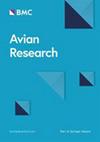eDNA提高了检测效率,但显示了较低的水鸟多样性:与点计数法的比较
IF 1.7
2区 生物学
Q1 ORNITHOLOGY
引用次数: 0
摘要
环境 DNA(eDNA)方法已成为研究各种生物类群的一种很有前途的工具。然而,利用 eDNA 对鸟类生物多样性进行的元标定研究却很少受到关注。在本研究中,我们比较了在中国东部太湖23个地点用eDNA元标定法和传统的点计数法获得的水鸟生物多样性,并评估了eDNA元标定法在水鸟群落研究中的准确性。点计数法记录的水鸟物种总数(22)高于 eDNA 技术(16)。虽然 eDNA 对水鸟物种的检出率达到 74.5%,在每个采样点识别出的物种数量(12.48 ± 1.97)明显多于点计数法(6.13 ± 2.69),特别是突出了一些稀有和难以捉摸的物种,但它未能检出点计数法通常观察到的一些物种。阿尔法多样性分析表明,除了 eDNA 方法显示出较低的 Pielou 均匀度之外,eDNA 方法与点计数方法在水鸟多样性方面没有显著差异。水鸟的 eDNA 序列丰度与物种出现率显著相关,而 Spearman 分析表明 eDNA 序列丰度与点计数法的物种丰度无显著差异。因此,eDNA 是评估湖泊中越冬水鸟多样性的有效补充工具,尽管它无法捕捉到水鸟群落的全部多样性。制定全面监测物种组成的采样策略,并将 eDNA 与传统调查方法相结合,对准确评估群落结构至关重要。本文章由计算机程序翻译,如有差异,请以英文原文为准。
eDNA enhances detection efficiency but reveals lower waterbird diversity: A comparison with point counting method
Environmental DNA (eDNA) methods have emerged as a promising tool for studying a broad spectrum of biological taxa. However, metabarcoding studies of avian biodiversity using eDNA have received little attention. In this study, we compared waterbird biodiversity derived from eDNA metabarcoding with that obtained from traditional point counting surveys at 23 sites in Tai Lake of eastern China and evaluated the accuracy of eDNA metabarcoding for waterbird community studies. The point counting method recorded a higher total number of waterbird species (22) compared to the eDNA technique (16). While eDNA achieved a 74.5% detection rate for waterbird species and was able to identify a significantly greater number of species (12.48 ± 1.97) at each sampling site than point counting method (6.13 ± 2.69), particularly highlighting several rare and elusive species, it failed to detect some species commonly observed by the point counting method. The alpha diversity analysis revealed no significant differences in waterbird diversity between the eDNA method and the point counting method, except that the eDNA method exhibited lower Pielou evenness. Waterbird eDNA sequencing abundance correlated significantly with species occurrence, whereas Spearman's analysis indicated no significant difference between eDNA sequence abundance and species abundance from the point counting method. eDNA method detected no significant difference in waterbird composition between sampling sites, while the point counting method revealed significant differences. Consequently, eDNA is an effective complementary tool for assessing the diversity of wintering waterbirds in lakes, though it is unable to capture the full diversity of waterbird communities. It is crucial to develop sampling strategies that comprehensively monitor species composition and integrate eDNA with traditional survey methods for accurate evaluation of community structure.
求助全文
通过发布文献求助,成功后即可免费获取论文全文。
去求助
来源期刊

Avian Research
ORNITHOLOGY-
CiteScore
2.90
自引率
16.70%
发文量
456
审稿时长
46 days
期刊介绍:
Avian Research is an open access, peer-reviewed journal publishing high quality research and review articles on all aspects of ornithology from all over the world. It aims to report the latest and most significant progress in ornithology and to encourage exchange of ideas among international ornithologists. As an open access journal, Avian Research provides a unique opportunity to publish high quality contents that will be internationally accessible to any reader at no cost.
 求助内容:
求助内容: 应助结果提醒方式:
应助结果提醒方式:


